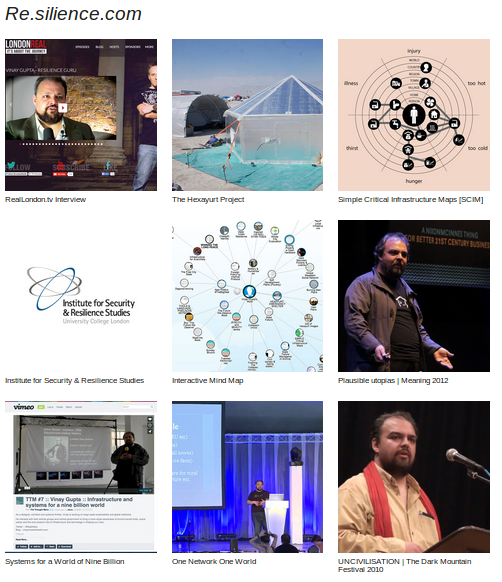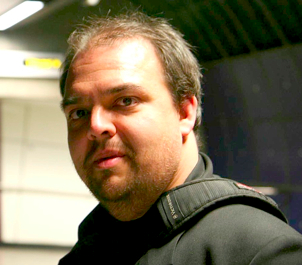About Vinay Gupta
Head over to Re.silience.com. It’s a much better starting point than here!
Click through to Re.silience.com.
(if you are interested in my professional work, try here)
I am trying to keep you alive.
There are lots of threats which governments are either ignoring or causing. I am filling in the gaps. Overconsumption is reducing our planet’s ability to support life. Seven of us exist for every person alive 200 years ago!
Nuclear war, bioweapons, even plain old conflict are driven by resource scarcity. Good engineering could at least double how far our resources can stretch, the rest has to be done by demand reduction: living within planetary limits. But governments do not fund engineering solutions to political problems, except in war, so the technologies which could bring plenty to the world (or at least more room for manoeuvre) are largely unfunded or undeployed.
A likely response to increasing resource scarcity (manifest as economic problems and rising prices) is centralization of power (fascism). In the past, hard right-wing governments have come to power during and after economic collapses, leading to unnecessary wars or even genocide. Democides (governments turning on their people) killed a quarter-billion people in the 20th century.
Finding better solutions than centralization and war is my life’s work.
To this end I’ve worked extensively with government, the military, some large companies and think-tanks – but most of all with the Free and open source community – to solve real problems. For maximum leverage I’ve done most of that work as a designer and model-builder, rather than managing demonstration projects.
Click here if your browser doesn’t support HTML5 video

This video me in action at Surviving the Event. This is pretty much what I am like.
Here is a visual index of my activities.
If you are professionally interested in my work, read on.
I am one of the world’s leading thinkers on infrastructure theory, state failure solutions, and managing global system risks including poverty/development and the environmental crisis.
I work at both the theoretical level, building models and mapping tools like Simple Critical Infrastructure Maps (used by US DOD) and at the completely practical level, where I am best known as the designer of the hexayurt, an award-winning replacement for the disaster relief tent which provides shelter at 20% the cost of a tent.
I have also just completed a book project, The Future We Deserve. I pulled together a group of 100 authors to write about the future, with an open brief, resulting in an amazingly diverse and challenging book. I think you’ll enjoy it. We used a very streamlined production process which is suitable for future works, too.
I helped start the US National Defense University STAR-TIDES program on humanitarian assistance, consulted on urban resilience for Arup, and am an associate fellow of the UCL Institute for Security and Resilience Studies.
You may find my perspective useful in three areas:
-
Managing geopoltical risk in your business and personal life – what if we lose one of the world’s reserve currencies, for example?
-
Strategic perspective on the global development crisis, too few resources for too many people, natural systems degradation – how can we solve this?
-
Philosophical and practical understanding of how to think about very, very large issues in a clear and coherent fashion at both a political and a technical level.
What can I do for you?
You can contact me by email.
The following is a cross-section of my work.
Recent activities
- I make extensive use of video to communicate, and train others to do the same. I recently released the Gupta State Failure Management Archive is 4.3gb of Public Domain/cc video lectures and documents. You can download it from archive.org or legal bittorrent.
- My Public todo list is fully editable. Please feel free to help if you can!
- Hexayurt – the world’s cheapest, most durable emergency shelter. Free/open source. Used extensively in a recreational context. Approaching formal field testing.
- Six Ways To Die – a simple, easy to remember model for managing personal risk. Used by the STAR-TIDES program.
- STAR-TIDES – US National Defense University humanitarian technology program. (founding member)
- Defense Horizons #70 – “STAR-TIDES and Starfish Networks: Supporting Stressed Populations with Distributed Talent” on decentralized disaster response for the prestigious US National Defense University Center for Technology and National Security Policy series. (co-author)
- Networked domestic disaster response – rehousing after “whole city” disasters like nuclear terrorism. Well reviewed by relevant authorities.
- Severe Pandemic Flu Strategies – the only non-classified work done on dealing with H5N1 bird flu if it goes pandemic at its full (60%) case fatality rate.
Access to Resources
- Global Swadeshi – the world’s largest social network for appropriate technology activists. The Guardian newspaper recently featured me as a Swadeshi advocate in a video interview. (I appear about half way through)
- Small is Profitable – The Economist’s Book of the Year 2003, on decentralized energy economics. (editorial team)
- Winning the Oil Endgame – Pentagon-funded study on getting the US to zero oil consumption in 20 years. (co-editor)
- The Future of Poverty/Ending Poverty with Open Hardware/Soft Development Paths – a local infrastructure and networked education plan for global poverty alleviation.
- The Global Village Development Bank – imagine if the World Bank was built around financing decentralized, distributed infrastructure using ICT to manage a hundred million projects globally
Managing States
- Simple Critical Infrastructure Maps – a simple and coherent model for mapping critical situations, from individual survival to state failure.
- Hexayurt Country – a national reconstruction plan for Haiti after the 2010 earthquake.
- State in a Box: Identity Services Architecture/CheapID – a genocide resistant biometrics standard particularly suitable for implementation in failed states. Focuses on providing identity services to combat poverty, not just security. Written for the Office of the Secretary of Defense with National Security Agency oversight.
- The Living City – urban resilience models and philosophy, commissioned by Arup.
- Institute for Collapsonomics – a working group on the theory and practice behind managing massive economic contractions. (founding member)
New Politics for a New Æon
- The Future We Deserve, which is about the role of collaboration in creating the future of the human species.
- The Big Deal which shows how the exercise of grass-roots political power might change the world.




Pingback: Akvo blog » Blog Archive » Breaking the Frame - Akvo on TV
Pingback: Akvo blog » Blog Archive » To coincide with today’s open source publication of Akvo’s video strategy, Vinay Gupta argues that “the collision of the internet and the poor is clearly a major turning point in human history, in w
Vinay,
Thank you so much for all the great work. What a whirlwind of activity and productivity you are! I first came upon your work while preparing to build a hexayurt at Burningman last year (it worked great!)
I just wanted to recognize you and publicly exclaim kudos. Do you still go to BM?
Cheers,
I like the idea. Couple of questions:
- Have you made metric versions of the plans? Inches and feet are Greek to them.
- Have you translated the instructions into French?
- Have you investigated what sized plywood sheets are typical in that part of the world (metric) and adapted the plans accordingly?
- I have not read through the plans yet, but have you thought about using a “stitch and glue” method for assembling these? This is used in assembling small boats and might be well adapted to Haiti (think of your yurt as an upside down boat!). See http://en.wikipedia.org/wiki/Stitch_and_glue
I saw this recently from a link on Warren Ellis’ blog.
http://www.d-shape.com/d_shape_presentation.pdf
I think something like this could be delivered into areas like Haiti or New Orleans with a preset design that could build more than temporary shelters.
The tech is obviously in its infancy, but I believe the potential to be nearly limitless. Armed with enough of these we could rebuild (or build for the first time) communities quickly.
Pingback: Crowd-sourced books, a passing fad? « Bjelkeman's travel notes
Pingback: Noah Raford » Three Innovations in Crowd Sourced Scenario Planning, Part 1
Pingback: Dr. Lovestrange or: How I Learned to Stop Worrying and Love Peak Oil « ASPO Ireland
Pingback: The Hexayurt – From An Invention To A Reality « Sarvodaya Media Blog
Pingback: The Bucky-Gandhi Design Institution › Hell of a life – Kanye West – and new year’s thoughts
Pingback: An evening with TEDxOrenda… « Patrick's Blog
Could one construct a Hexayurt out of corrugated plastic panels such as corriboard (6mm, 9mm or 10mm thicknesses) ?
I’m trying to figure out ways to make the hexayurt lighter and easier to transport.
How can you help us to sert a very good model of village development bank in our country please we realy need the model.
Thanks
I would like to use AAC (aerated autoclave concrete ) to produce these hexayurt panels. Is this feasible ?
M Ryan
Hello again, Vinay…
I would like to speak with you about using concrete construction.
Some of your readers are interested in aerated autoclave concrete.
I have a new process that utilizing an extremely fast-curing cement which allows an ATSM “28-day cure” within six to eight hours and permits very rapid demolding within 3 to 4 hours.
Please let’s talk sometime.
Cheers,
Dr. Glenn Edward Roy
.